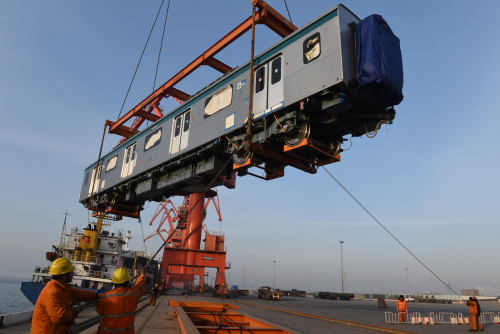 |
|
SUCCESS ON TRACK: Workers lift a subway rail car that is about to be shipped to Brazil on the dock of Yingkou Port, northeast China's Liaoning Province, on November 25 (XINHUA) |
Internet Finance
China will continue to support the development of Internet finance amid moderate government regulation, Pan Gongsheng, Vice Governor of the People's Bank of China, the country's central bank, said on November 26.
The central bank is considering issuing a guideline, in cooperation with other financial watchdogs, on Internet finance centered on openness and inclusiveness, Pan said.
Online financing holds a promising future, he said, adding that national encouragement for online financing has been explicitly presented in the 2014 Central Government work report at the legislative session in March.
If used right, it can play a very active role in promoting the country's real economy, Pan said.
But he also warned of the potential risks for online finance, calling self-regulation a duty among practitioners.
The finance industry is a high risk area, Pan said. The problems are usually elusive and contagious and often break out suddenly, plaguing both themselves and other economic entities.
Internet finance companies should strengthen legal awareness and actively safeguard a fair and transparent market environment, Pan said.
The regulators will also carry out regular exchanges of ideas to make the regulations more feasible and keep a dynamic pace with the fast changing practices of online financing, Pan added.
Deficit Decreasing
China recorded a smaller deficit in service trade in October, data from the State Administration of Foreign Exchange (SAFE) showed on November 26.
The country's service trade deficit reached 105.6 billion yuan ($17.25 billion) in October, compared with 133.4 billion yuan ($21.73 billion) in September.
Income from trade in services stood at 75.9 billion yuan ($12.36 billion) last month, while expenditure in service trade reached 181.5 billion yuan ($29.57 billion).
In the first 10 months, the aggregate service trade deficit totaled 824 billion yuan ($134.23 billion), with 1.05 trillion yuan ($171.1 billion) in revenues and 1.87 trillion yuan ($304.8 billion) in spending.
The SAFE started to issue monthly data on the services trade in January 2014 to improve the transparency of the balance of payments statistics.
Distinct from merchandise trade, trade in services refers to the sale and delivery of intangible products like transport, tourism, telecommunication, construction, advertising, computing and accountancy.
General Aviation
More efforts should be made to promote the "fast and healthy" growth of China's general aviation industry and strengthen its contribution to economic and social development as well as national defense, Chinese Vice Premier Ma Kai said on November 22.
Ma made the remarks at an industry meeting on low-altitude airspace management reform, saying this reform has entered a "crucial stage and many problems remain to be solved."
China has a total number of 226 general aviation companies and 1,786 general aircraft including helicopters, according to the Civil Aviation Administration of China (CAAC).
It is expected that China's general aircraft will surpass 5,000 by 2020, with an annual growth rate at around 19 percent, representing a new economic engine and an industry with a potential market demand at $15.5 billion, said CAAC Deputy Director Wang Zhiqing.
General aviation refers to all civil aviation operations other than scheduled air services, and general aircraft range from helicopters to private jets.
General aircraft can fly in the low-altitude airspace below 1,000 meters in China and policymakers are mulling over lifting that altitude.
"The bottlenecks facing the general aviation industry are not only airspace resources but also a lack of general aviation airports, temporary landing sites, fuel supply and pilots," Wang said.
China has only 65 general aviation airports, about 300 temporary landing sites and only one oil refiner producing general aviation fuel, CAAC figures showed.
